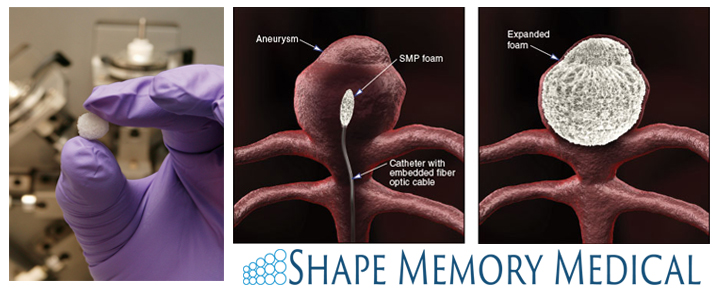Shape-Changing Device Treats Aneurysm Patients
Every year, 60,000 people are diagnosed with brain aneurysms, weakened portions of arterial vessels that create sacs of high-pressure blood. Although small, aneurysms that burst can cause massive tissue damage, stroke, and death. Current treatments continue to carry associated risks that compromise their efficiency, such as base-clamping to seal and pinch off aneurysms—which fails to treat aneurysms with wider necks—and inserting expanding metal coils to clot and disintegrate sacs—which often unravel or become compressed, leading to the recurrence of blood flow.
In 2004, however, the Lawrence Livermore National Laboratory (LLNL) and UC Davis were awarded a five-year Bioengineering Research Partnership Grant to investigate polymers as a mechanism for treating the risks of aneurysms. The study, led by principal investigator Dr. Duncan Maitland, focused on shape memory polymers (SMP), smart materials that undergo physical and molecularly structural metamorphoses between deformed and permanent states in response to changing temperatures. An SMP is first shaped at a high threshold temperature to achieve a desired permanent shape. After removal from the high-temperature environment, the SMP is again molded to a desired temporary shape. When subjected to stimulus temperatures above or below its transition threshold temperature, the SMP reconfigures its structure from the temporary form to the permanent form and vice versa. Temperature-dependent metamorphosis makes SMPs excellent candidates for medical devices because they can be compact during operational delivery and expand to functional forms with body temperature.

These polymers showed immense promise as memory foam–coated, metal coils with extremely low density, enabling them to undergo substantial changes in volume—up to 100 times that of its compressed volume—and be easily delivered via arterial micro-catheter. SMPs can fill aneurysms with only 1–2 foams and with 1000 times less expansion force than the traditional metal coils that resulted in 70% of aneurysm volume being unfilled.
In January of 2008, Maitland continued developing SMPs for this application at Texas A&M University (TAMU). That September, TAMU and LLNS reached an inter-institutional agreement to begin commercialization. A year later in June of 2009, Maitland founded Shape Memorial Medical Inc. (formerly DEP Shape Memory Therapeutics) as a medical device company that commercializes SMP-based innovations and, as CEO, secured initial capital from Texas Emerging Technologies Fund and Research Valley Angel Fund as well as millions of dollars in technology development funds from the National Institutes of Health, Department of Energy, and LLNL. An exclusive licensing agreement between LLNS and Shape Memory Medical was finalized in July of 2010, leading to 12 issued patents, 15 pending patents, and regulatory path launch dates in European and United States markets in 2016 and 2017, respectively.
Shape memory polymers are already a disrupting technology within the greater medical market and promise to have continued impact in the cerebral aneurysm market. With material costs as low as $10 per pound and operational time and complexity cut by 50% when compared to similar alternatives, SMPs will redefine the $700 million detachable coil market (average 16% CAGR) and $1.5 billion neurovascular market (20% CAGR) as the preferred material and treatment option for mitigating aneurysm risk.

